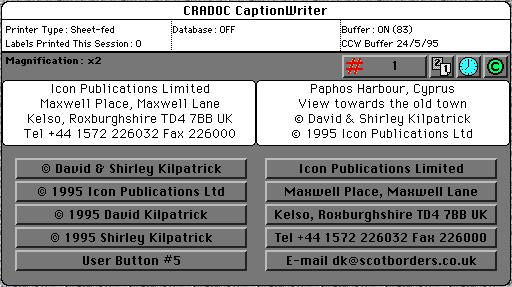
One full-size screen shot says it all - most aspects of the program are self-explanatory. The buttons store user-defined frequently used text lines, but otherwise, entry is free form
THE LESS memory you can get away with on a laptop computer, the better. Slower processors, smaller RAM and programs which demand very little disk-spinning extend the battery life of machines like Mac PowerBooks. This is one reason why WriteNow 3.0 is a popular word processor for those on the move - it can run on a basic 68000 Mac (now obsolete) with only 2 megs of RAM.
There is no such lean, clean database program. The popular choice, Claris FileMaker Pro, is hungry for RAM and disk space and runs slowly on minimal machines. But photographers on the move, getting E6 processed on location and needing to file stock or feature images back by mail to home base, need a database and captioning program which can be used on almost any machine.
Here, Cradoc CaptionWriter V from Perfect Niche Software, distributed in the UK by Iris Audio Visual, offers great advantages. The Mac program is only 196Kb on the disk and can run with less than 400Kb of free RAM; it works on any Macintosh from a Plus up, including the discontinued 68000-based PowerBook 100 which is still popular with journalists as a text-only lightweight.
The PC version runs in DOS on anything from an XT upwards with only 256Kb RAM - ideal for finding a new use for that obsolete pre-Windows machine.
CaptionWriter supports almost any printer and label size, from 84 35mm slides on an A4 laser sheet to dot matrix or sheet fed portable ink jet. Be careful, however, when buying Avery labels; they are not exactly the same as the proprietary labels, and some users report that it is not possible to get 5 lines per label on these.
Tested under 68020 emulation on a Mac 8100/110 CaptionWriter V was slow, buggy and almost unusable. On the little PowerBook 100 (around 1/30th as fast!) it was fast, bug-free and totally competent.
CaptionWriter has grown since its earlier forms; it can save and open mini-database files and perform freeform searches, range selective repeat print-outs, and simple file management. A size of 1,000 slides per database is recommended - enough to allow each shoot to be stored as a single file. When the database is opened, the latest record is displayed automatically, and new data need only be typed over the parts you want to change. Your copyright, date, address and so on can remain untouched. Most 'new' records - typically of one label with the address and one with the photo data - involve only one or two lines of typing. Serial numbers, dates and even the time down to the second can be added by single mouse-clicks, as can standard elements like address lines stored in ten user-defined field buttons displayed below the label text entry windows.
Navigation is very easy, using arrow buttons or the keyboard. Using up/down arrow keys automatically moves through each full line of type in the two label fields for over-writing. You can caption with lightning speed; multiple slides of the same subject just need repeated clicking of the add button (or command-D keystroke) and new records are added and optionally serial numbered.
The completed labels can be written to disk buffer files, saved and named if needed, and printed as each sheet's-worth is completed or at any future time when a printer is available.
CaptionWriter V does not entirely conform to the Mac interface - aspects of keyboard control, highlighting and behaviour of the cursor are non-Mac-like. However, these are not bugs, just quirks. The manual is dreadful - it devotes page after page to print buffers but does not explains well how to create a caption database from scratch. As a low-cost package (�57.50 + carriage and VAT in the UK) CaptionWriter is a bargain despite this, ideal for use on very basic machines and portables.
Return to July contents